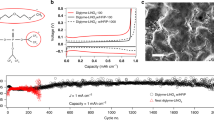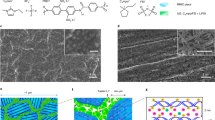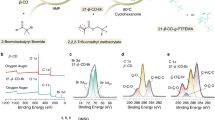Abstract
Polymer electrolytes—salts (such as LiCF3SO3) dissolved in solid, high-molar-mass polymers (for example, poly(ethylene oxide), PEO)1,2,3—hold the key to the development of all-solid-state rechargeable lithium batteries4. They also represent an unusual class of coordination compounds in the solid state5. Conductivities of up to 10−4 S cm−1 may be obtained, but higher levels are needed for applications in batteries5,6,7. To achieve such levels requires a better understanding of the conduction mechanism, and crucial to this is a knowledge of polymer-electrolyte structure. Crystalline forms of polymer electrolytes are obtained at only a few discrete compositions. The structures of 3 : 1 and 4 : 1 complexes (denoting the ratio of ether oxygens to cations) have been determined5,8,9. But the 6 : 1 complex is of greater interest as the conductivity of polymer electrolytes increases significantly on raising the polymer content from 3 : 1 to 6 : 1 (refs 10, 11). Furthermore, many highly conducting polymer-electrolyte systems form crystalline 6 : 1 complexes whereas those with lower conductivities do not. Here we report the structure of the PEO:LiAsF6 complex with a 6 : 1 composition. Determination of the structure was carried out abinitio by employing a method for flexible molecular structures, involving full profile fitting to the X-ray powder diffraction data by simulated annealing12. Whereas in the 3 : 1 complexes the polymer chains form helices, those in the 6 : 1 complex form double non-helical chains which interlock to form a cylinder. The lithium ions reside inside these cylinders and, in contrast to other complexes, are not coordinated by the anions.
This is a preview of subscription content, access via your institution
Access options
Subscribe to this journal
Receive 51 print issues and online access
$199.00 per year
only $3.90 per issue
Buy this article
- Purchase on Springer Link
- Instant access to full article PDF
Prices may be subject to local taxes which are calculated during checkout


Similar content being viewed by others
References
Gray, F. M. Polymer Electrolytes (Materials monographs, Royal Society of Chemistry, Cambridge, (1997).
Scrosati, B. (ed.) Application of Electroactive Polymers (Chapman & Hall, London, (1993).
Bruce, P. G. (ed.) Solid State Electrochemistry(Cambridge Univ. Press, (1995).
Baril, D., Michot, C. & Armand, M. Electrochemistry of liquids vs. solids: polymer electrolytes. Solid State Ionics 94, 35–47 (1997).
Bruce, P. G. Coordination chemistry in the solid state. Phil Trans. R. Soc. Lond. A 354, 415–436 (1996).
Wright, P. V., Zheng, Y., Bhatt, D., Richardson, T. & Ungar, G. Supramolecular order in new polymer electrolytes. Polym. Int. 47, 34–42 (1998).
Golodnitsky, D. & Peled, E. Electrochim. Acta(in the press).
Chatani, Y. & Okamura, S. Crystal-structure of poly(ethylene oxide)–sodium iodide complex. Polymer 28, 1815–1820 (1987).
Lightfoot, P., Nowinski, J. L. & Bruce, P. G. Crystal-structures of the polymer electrolytes poly (ethylene oxide)4–MSCN (M = NH4, K). J. Am. Chem. Soc. 116, 7469–7470 (1994).
Angell, C. A. Fast ion motion in glassy and amorphous materials. Solid State Ionics 9/10, 3–16 (1983).
Cowie, J. M. G., Martin, A. C. S. & Firth, A.-M. Ionic conductivity in mixtures of salts with comb-shaped polymers based on ethylene oxide macromers. Br. Polym. J. 20, 247–252 (1988).
Andreev, Y. G., Lightfoot, P. & Bruce, P. G. Ageneral Monte Carlo approach to structure solution from powder-diffraction data: application to poly(ethylene oxide)3:LiN(SO2CF3)2. J. Appl. Crystallogr. 18, 294–305 (1997).
Thomson, J. B., Lightfoot, P. & Bruce, P. G. Structure of polymer electrolytes: the crystal structure of poly(ethylene oxide)4:RbSCN. Solid State Ionics 85, 203–208 (1996).
Lightfoot, P., Mehta, M. A. & Bruce, P. G. Crystal-structure of the polymer electrolyte poly(ethylene oxide)3LiCF3SO3. Science 262, 883–885 (1993).
Chatani, Y., Fujii, Y., Takayanagi, T. & Honma, A. Structures of 2 crystal forms of poly(ethylene oxide)–sodium thiocyanate complex with molar ratios of 3–1 and 1–1. Polymer 31, 2238–2244 (1990).
Andreev, Y. G., MacGlashan, G. S. & Bruce, P. G. Ab initio solution of a complex crystal structure from powder-diffraction data using simulated-annealing method and a high degree of molecular flexibility. Phys. Rev. B 55, 12011–12017 (1997).
Rietveld, H. M. Aprofile refinement method for nuclear and magnetic structures. J. Appl. Crystallogr. 2, 65–71 (1969).
Larson, A. C. & Von Dreele, R. B. GSAS, General Structure Analysis System (Los Alamos National Laboratory rep. no. LA-UR-86-748, Los Alamos, (1987).
Frech, R., Chintapalli, S., Bruce, P. G. & Vincent, C. A. Structure of an amorphous polymer electrolyte, poly(ethylene oxide)3:LiCF3SO3. J. Chem. Soc. Chem. Commun. 157–158 (1997).
Parker, J. M., Wright, P. V. & Lee, C. C. Adouble helical model for some alkali metal ion–poly(ethylene oxide) complexes. Polymer 22, 1305–1307 (1981).
Bruce, P. G., MacGlashan, G. S. & Andreev, Y. G. Implications of Molecular and Materials Structure for New Technologies (eds Howard, J. A. & Allen, F. H.) NATO Science Series E: Applied Sciences, Kluwer, Dordrecht, in the press).
Dias, F. B.et al. Ionic conduction of lithium, sodium and magnesium salts within organised smectic liquid crystal polymer electrolytes. Electrochim. Acta 43, 1217–1244 (1998).
Werner, P.-E., Eriksson, L. & Westdahl, M. TREOR, a semi-exhaustive trial-and-error powder indexing program for all symmetries. J. Appl. Crystallogr. 18, 367–370 (1985).
Acknowledgements
We thank D. Martin and D. Engberg for their help in collection and treatment of the OSIRIS data. P.G.B. thanks the EPSRC and the Leverhulme trust for financial support.
Author information
Authors and Affiliations
Corresponding author
Rights and permissions
About this article
Cite this article
MacGlashan, G., Andreev, Y. & Bruce, P. Structure of the polymer electrolyte poly(ethylene oxide)6:LiAsF6. Nature 398, 792–794 (1999). https://doi.org/10.1038/19730
Received:
Accepted:
Issue Date:
DOI: https://doi.org/10.1038/19730
This article is cited by
-
A soft co-crystalline solid electrolyte for lithium-ion batteries
Nature Materials (2023)
-
A flexible solid polymer electrolyte enabled with lithiated zeolite for high performance lithium battery
Nano Research (2023)
-
Ionic conductivity enhancement of PVA: carboxymethyl cellulose poly-blend electrolyte films through the doping of NaI salt
Cellulose (2022)
-
Dynamics of a driven damped particle in the presence of a magnetic field: Asymmetric splitting of the output signal
Pramana (2022)
-
Progress on High Voltage PEO-based Polymer Solid Electrolytes in Lithium Batteries
Chemical Research in Chinese Universities (2022)
Comments
By submitting a comment you agree to abide by our Terms and Community Guidelines. If you find something abusive or that does not comply with our terms or guidelines please flag it as inappropriate.



